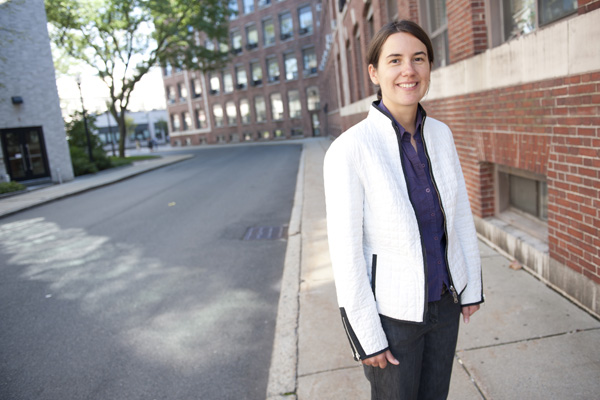Using math to explore the universe

Alina Marian, a new associate professor of mathematics in Northeastern University’s College of Science, thinks of geometry as not just the study of shapes but a look into heart of the universe and its origins.
“It’s the most abstract end of science—it’s mathematics at its core,” said Marian of her research, which is tied to the emerging study of string theory. “It’s about trying to make sense of the physics of the first fraction of time in the life of the universe, which is of course interesting and complicated.”
Marian received her Ph.D. from Harvard and comes to Northeastern from the University of Illinois at Chicago, where she was a tenured associate professor. She has been a Gibbs Assistant Professor at Yale University, a postdoctoral fellow at Stanford University and a member of the Institute of Advanced Study at Princeton.
Her research spans several areas of mathematics including moduli theory in algebraic geometry, representation theory, complex geometry and string theory—all fields that overlap with the study of physics.
“At first, I was interested in physics and philosophy—like everyone, you want to better understand the world,” Marian said. “Then I was drawn into mathematics, which allows you to explore and understand topics conceptually. Mathematics allows you to understand our interesting world in a way you can’t do in any other field.”
Marian said her research into string theory—a field only a few decades old—is exciting because she can play an important role in exploring the origins of new ideas.
“If you look at the history of mathematics, ideas have a long range,” Marian said. “And these ideas can impact a lot of math not just years down the road, but decades and centuries into the future.”
This fall, Marian is teaching a math course for engineers on calculus and differential equations. After this semester, her courses will run the gamut, teaching a freshmen introduction to high-level mathematics to courses designed for advanced graduate students.
She said she hopes students of math and physics are drawn into this new field of research because it is still so untapped.
“There are plenty of problems and plenty of openings,” Marian said. “When you’re a graduate student, you want to work in a field that’s not at its end. Math is certainly an old subject, but it’s been rejuvenated over the last two decades. It’s certainly not a field that’s on its deathbed.”





